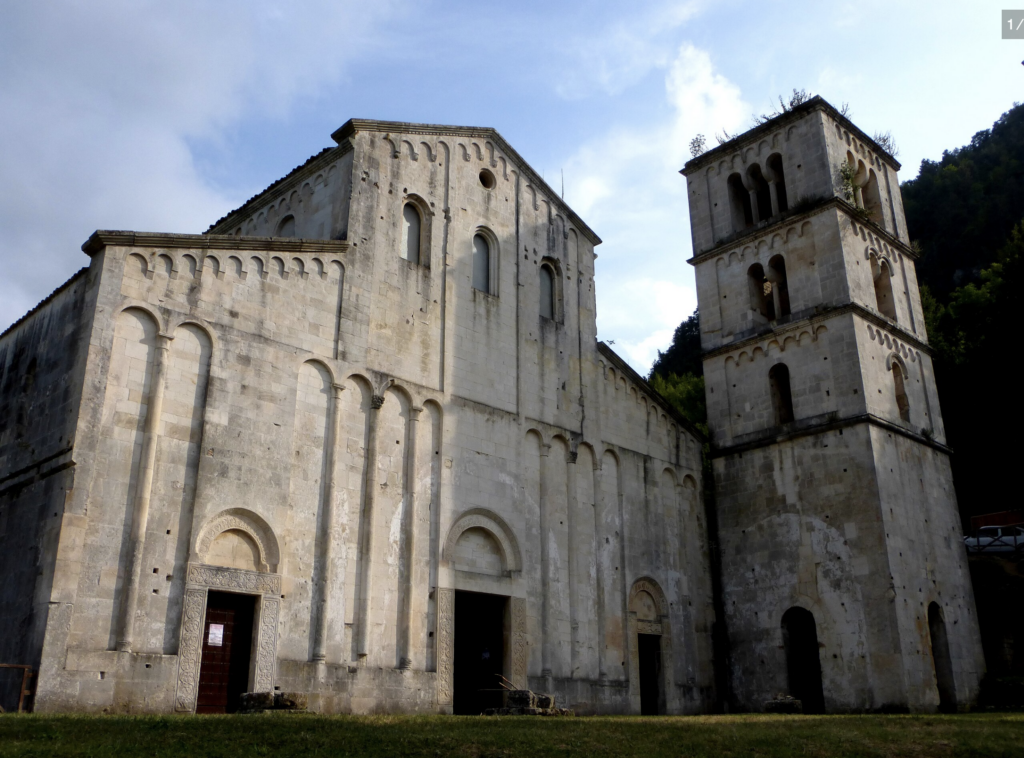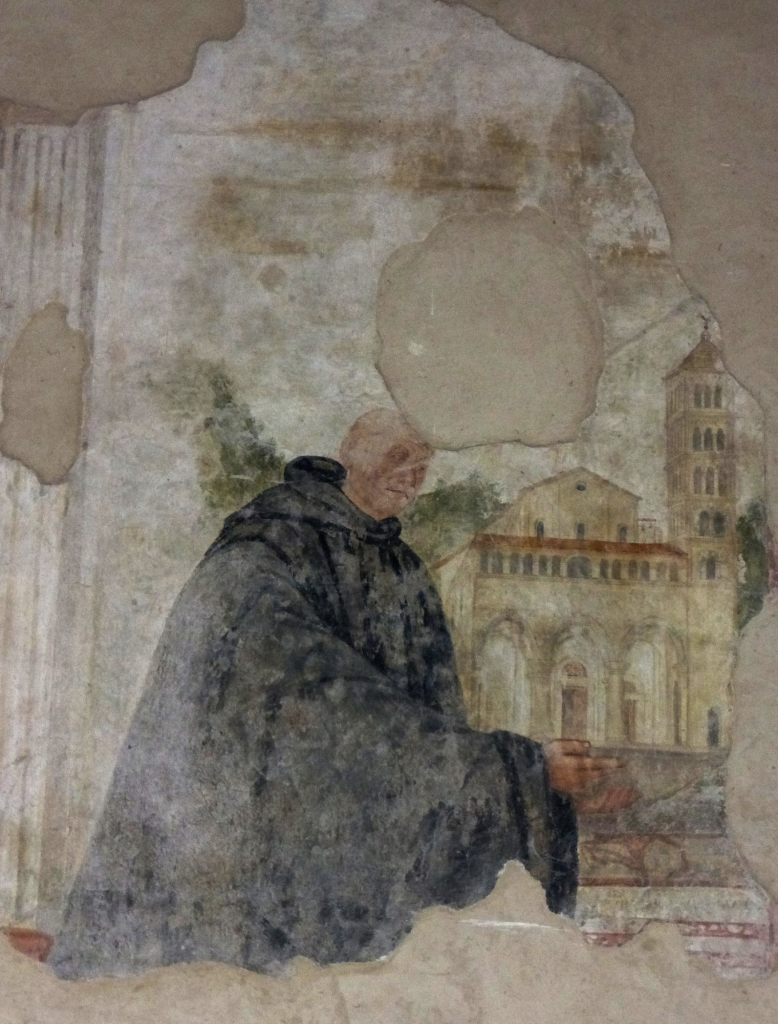
L’abbazia di San Liberatore alla Maiella, situata nel comune di Serramonacesca (Pescara), è uno dei monasteri più antichi dell’Abruzzo. Intitolata a Cristo Liberatore, fu dichiarata monumento nazionale nel 1902. La sua fondazione, tradizionalmente attribuita a Carlo Magno, risale storicamente al IX secolo. La struttura ha attraversato numerose fasi di ricostruzione e ristrutturazione, consolidando nel tempo il suo ruolo centrale come presidio dell’abbazia di Montecassino in Abruzzo fino al XVIII secolo.
Storia
L’abbazia viene citata per la prima volta nel IX secolo, quando il suo patrimonio si estendeva dalla Maiella all’Adriatico, includendo territori come Serramonacesca, Manoppello e Roccamontepiano. Nel 1007, il monaco Teobaldo ricostruì la chiesa e gli edifici comunitari, documentando il suo lavoro in un inventario che attestava la ricchezza liturgica e culturale dell’abbazia. Teobaldo, che vi fu sepolto, è ricordato come una figura fondamentale per la crescita della comunità monastica. Nel 1070 l’abate Desiderio di Montecassino, con il monaco Adenolfo, rinnovò completamente la chiesa, portando nuove maestranze che fondarono una scuola artistica locale.
Nonostante il prestigio, l’abbazia iniziò a declinare dal XV secolo, subendo le sorti delle badie cistercensi, e finì in commenda sotto abati estranei al territorio. Un terremoto nel 1706 danneggiò ulteriormente la chiesa, che fu restaurata in stile barocco. Gli affreschi rinascimentali celebrano l’ultimo periodo di splendore del monastero, che visse anni di abbandono fino al restauro tra il 1967 e il 1971, sotto la direzione di Mario Moretti.
Architettura
L’abbazia sorge in un contesto naturalistico di grande valore, con una facciata bianca, equilibrata e sobria, affiancata da un campanile quadrangolare a tre piani decorato da monofore, bifore e trifore. La chiesa presenta uno schema architettonico di ispirazione lombarda, con tre navate divise da sette arcate su pilastri quadrangolari. L’accesso al presbiterio avviene attraverso tre archi trionfali, di cui il centrale manca, decorati con motivi romanici a ovuli e dentelli. Il pavimento policromo della navata centrale, databile al 1200, è un esempio raro di geometria medievale.
Le pareti interne, decorate in passato con affreschi, conservano tracce delle opere più antiche, mentre il soffitto è a capriate lignee. Dalla navata sinistra si accedeva al chiostro e alla residenza del monastero, di cui restano due porte romaniche decorate, una delle quali presenta il caratteristico motivo floreale abruzzese.
Affreschi
La chiesa conserva due cicli di affreschi medievali, danneggiati gravemente dalla mancanza del tetto per un lungo periodo. Gli affreschi duecenteschi nell’abside, attribuiti al periodo dell’abate Bernardo Ayglerio, illustrano episodi legati alla storia del monastero, come Teobaldo che offre un modellino della chiesa a San Benedetto e Carlo Magno che conferma i diritti dell’abbazia. Al centro, San Benedetto è raffigurato con il pastorale di vescovo-abate, benché oggi l’immagine sia parzialmente visibile.
Nel Cinquecento, altri affreschi furono realizzati per coprire le opere più antiche; recentemente staccati, sono oggi esposti su pannelli nella navata destra. Questi affreschi, influenzati da stili lombardi e veneti, rappresentano l’ultimo bagliore artistico di un’abbazia che testimonia la ricchezza culturale e religiosa dell’Abruzzo medievale.
The Abbey of San Liberatore alla Maiella, located in the municipality of Serramonacesca (Pescara), is one of the oldest monasteries in Abruzzo. Dedicated to Christ the Liberator, it was declared a national monument in 1902. Traditionally attributed to Charlemagne, its foundation actually dates back to the 9th century. Over time, the structure underwent several phases of reconstruction, serving as a central hub for the Abbey of Montecassino in Abruzzo until the 18th century.
History
The abbey is first mentioned in the 9th century when its holdings extended from the Maiella to the Adriatic, encompassing areas such as Serramonacesca, Manoppello, and Roccamontepiano. In 1007, the monk Theobald rebuilt the church and its community buildings, documenting his work in an inventory that highlighted the abbey’s liturgical and cultural wealth. Theobald, who was later buried there, is remembered as a key figure in the abbey’s development. In 1070, Abbot Desiderius of Montecassino, together with the monk Adenolf, completely renovated the church, introducing new craftsmen who established a local artistic school.
Despite its prestige, the abbey began to decline in the 15th century, following the fate of Cistercian monasteries, and fell under commendatory abbots from outside the region. A 1706 earthquake caused significant damage, leading to baroque-style restorations. The Renaissance frescoes within the church represent the last period of the monastery’s splendor. After long years of neglect, the abbey was restored between 1967 and 1971 under the direction of Mario Moretti.
Architecture
The abbey stands in a scenic natural setting, with a white, balanced, and understated façade flanked by a square bell tower with three levels adorned with single, double, and triple-lancet windows. The church follows a Lombard-inspired architectural scheme, with three naves divided by seven arches resting on quadrangular pillars. Access to the presbytery is through three triumphal arches—one of which is missing—decorated with Romanesque motifs such as egg-and-dart and dentil patterns. The polychrome geometric floor of the central nave, dating to the 13th century, is a rare example of medieval design.
The interior walls, once adorned with frescoes, retain traces of the original works, while the ceiling features wooden trusses. The left nave provides access to the cloister and monastic residence, where two Romanesque decorated doors remain. One of these features a characteristic Abruzzese floral motif.
Frescoes
The church preserves two cycles of medieval frescoes, severely damaged due to the long period during which the roof was missing. The 13th-century frescoes in the apse, attributed to the time of Abbot Bernard Ayglerius, depict episodes from the abbey’s history, such as Theobald offering a model of the church to Saint Benedict and Charlemagne confirming the abbey’s rights. At the center, Saint Benedict is portrayed holding the pastoral staff of a bishop-abbot, although the image is now partially visible.
In the 16th century, newer frescoes were added to cover the older ones; these have recently been detached and are now displayed on panels in the right nave. These frescoes, influenced by Lombard and Venetian styles, represent the final artistic expression of an abbey that bears witness to the cultural and religious richness of medieval Abruzzo.


